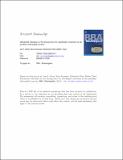Vibrational relaxation as the driving force for wavelength conversion in the peridinin-chlorophyll a-protein
Date
12/2015Metadata
Show full item recordAbstract
Abstract We present a computationally derived energy transfer model for the peridinin-chlorophyll a-protein (PCP), which invokes vibrational relaxation in the two lowest singlet excited states rather than internal conversion between them. The model allows an understanding of the photoinduced processes without assuming further electronic states or a dependence of the 2Ag state character on the vibrational sub-state. We report molecular dynamics simulations (CHARMM22 force field) and quantum mechanics/molecular mechanics (QM/MM) calculations on PCP. In the latter, the QM region containing a single peridinin (Per) chromophore or a Per-Chl a (chlorophyll a) pair is treated by density functional theory (DFT, CAM-B3LYP) for geometries and by DFT-based multireference configuration interaction (DFT/MRCI) for excitation energies. The calculations show that Per has a bright, green light absorbing 2Ag state, in addition to the blue light absorbing 1Bu state found in other carotenoids. Both states undergo a strong energy lowering upon relaxation, leading to emission in the red, while absorbing in the blue or green. The orientation of their transition dipole moments indicates that both states are capable of excited-state energy transfer to Chl a, without preference for either 1Bu or 2Ag as donor state. We propose that the commonly postulated partial intramolecular charge transfer (ICT) character of a donating Per state can be assigned to the relaxed 1Bu state, which takes on ICT character. By assuming that both 1Bu and 2Ag are able to donate to the Chl a Q band, one can explain why different chlorophyll species in PCP exhibit different acceptor capabilities.
Citation
Götze , J P , Karasulu , B , Patil , M & Thiel , W 2015 , ' Vibrational relaxation as the driving force for wavelength conversion in the peridinin-chlorophyll a-protein ' , Biochimica et Biophysica Acta - Bioenergetics , vol. 1847 , no. 12 , pp. 1509–1517 . https://doi.org/10.1016/j.bbabio.2015.07.011
Publication
Biochimica et Biophysica Acta - Bioenergetics
Status
Peer reviewed
ISSN
0005-2728Type
Journal article
Collections
Items in the St Andrews Research Repository are protected by copyright, with all rights reserved, unless otherwise indicated.

